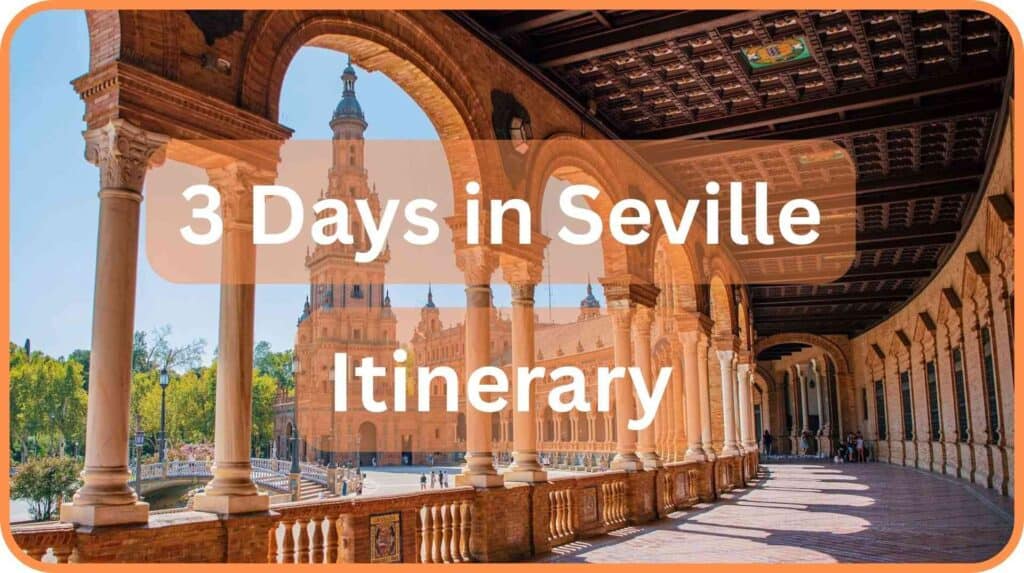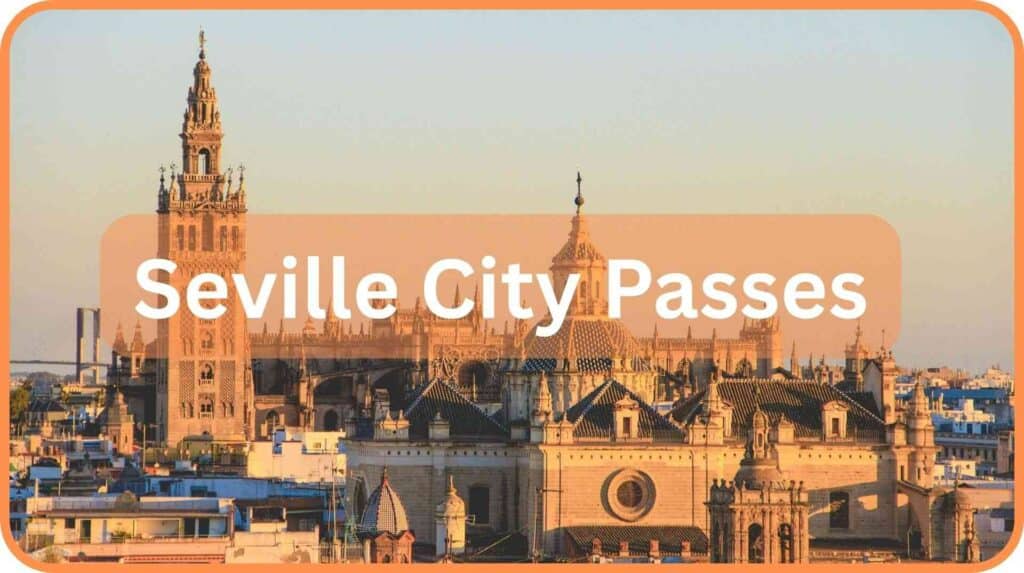Seville Itineraries
Top Attractions
- Royal Alcazar
- Seville Cathedral
- Metropol Parasol (Las Setas)
- Seville Bullring
- Plaza de Espana
- Casa de Pilatos
- Flamenco Show
- Maria Luisa Park
- Archivo de Indias
- Torre del Oro
- Seville Tiles (Azulejos)
- Bullfighting
- Football Stadium Tour
- Opera House
- Museum of Illusions
- Seville Aquarium
- Isla Mágica
- Jardines de Murillo
Disclaimer
Posts on visit-seville.com may contain affiliate links, meaning we get a small commission if you decide to make a purchase through our links, at no cost to you. Any income earned helps maintain this website and keeps it ad-free.
Seville Tram Guide 2025 – Tickets, Times & Map
How to Use the Seville Tram (MetroCentro) as a Visitor
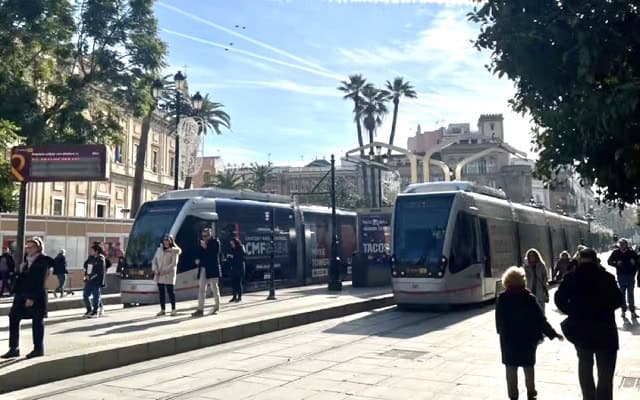
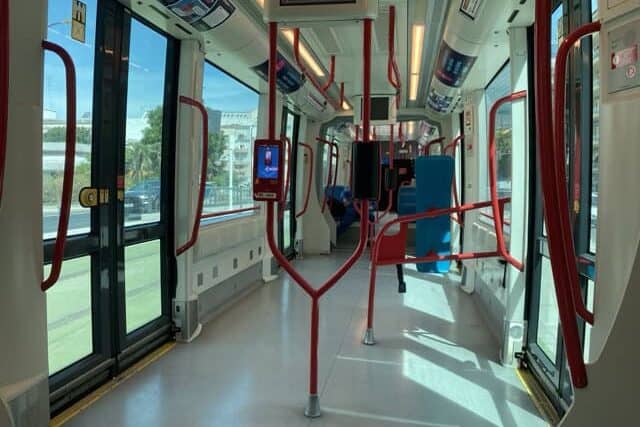
The Seville tram (MetroCentro) is a short modern light rail line operated by TUSSAM, mainly serving the historic centre. Locals use it as a quick way to cross Avenida de la Constitución without the hassle of traffic, while visitors find it a convenient route to landmarks such as the Cathedral of Seville, María Luisa Park, and the Archivo de Indias.
Although the line is limited, the ride is clean, efficient, and offers a scenic glimpse of Seville’s beautiful streets.
Seville Tram – General Information |
|
Route |
The tram line (T1 MetroCentro) runs from Plaza Nueva in the city centre to Nervión, stopping at key points to visit the main Seville landmarks. (See Seville tram route map) |
Times and Frequency |
Daily start: around 06:00 (including public holidays) |
Tickets and Prices |
A single tram ticket costs €1.40. |
Seville Tram Operating Times 2025
The Seville Tram (MetroCentro) runs every day of the week, including public holidays. Services begin around 6:00 in the morning and finish at 23:30 from Sunday to Thursday, with extended hours until 2:00 in the morning on Fridays and Saturdays.
Trams typically run every 7 to 10 minutes during the day, and the full journey from Luis de Morales to Plaza Nueva takes 21 minutes approximately.
During Seville’s major festivals such as Holy Week, the April Fair, or Christmas, additional services and longer hours are often introduced to accommodate the large crowds.
For the latest information and updates, check the official Seville Tram website.
Seville Tram Tickets: How to Buy
There are three main ways to pay for the Seville Tram (MetroCentro). The most traditional option is to buy a single ticket at the machines in each station, which costs €1.40. This works well if you only plan to use the tram once or twice, although there is no discount for return journeys.
A faster alternative is to simply tap your debit or credit card on the machines inside the tram. The fare is the same as a single ticket (€1.40), and it saves you from queuing at the station. However, the validators inside can sometimes be out of order, so you may need to try another machine on board. Be sure to always validate your card, as ticket inspectors carry out random checks.
The most cost-effective option for frequent travel is the Tarjeta Turista, a tourist pass that gives unlimited use of the tram and all TUSSAM buses. It is available as a 1-day card (€5) or a 3-day card (€10). A refundable deposit of €1.50 is added for the physical card, which you get back when you return it. The Tarjeta Turista is personal and cannot be shared, and the most central place to buy it is at TUSSAM Customer Service by Prado de San Sebastián station.
Tip – Which Seville Tram Ticket Should You Choose?
If you only need the tram for one or two rides, a single ticket or contactless payment is the easiest choice. But if you plan to use Seville’s buses and trams several times during your stay, the Tarjeta Turista offers much better value.
Seville Tram Line and Stations
The Seville Tram (MetroCentro) consists of a single line that runs through the historic centre and into the Nervión district. Originally just 2.2 km long, the line has been extended in stages and now includes eight stations as of late 2024, with further extensions planned toward Santa Justa railway station.
| Station | Nearby Attractions |
|---|---|
| Plaza Nueva | Ayuntamiento (City Hall), main shopping streets Calle Tetuán & Calle Sierpes |
| Archivo de Indias | Cathedral of Seville, Archivo de Indias, Real Alcázar |
| Puerta de Jerez | Torre del Oro, University of Seville (Rectorado), Hotel Alfonso XIII |
| Prado de San Sebastián | Prado Gardens, Prado bus station, north entrance to María Luisa Park |
| San Bernardo | San Bernardo station (Regional trains), Metro Line 1 |
| San Francisco Javier | |
| Eduardo Dato | Ramón Sánchez-Pizjuán (Sevilla FC) Stadium, Nervión Plaza shopping centre |
| Luis de Morales | El Corte Inglés (Nervión) department store, Nervión neighbourhood |
You’ll find the map displayed inside every tram, making it easy to follow your route as you travel through the city. To help you plan ahead, here’s the full Seville Tram Map:
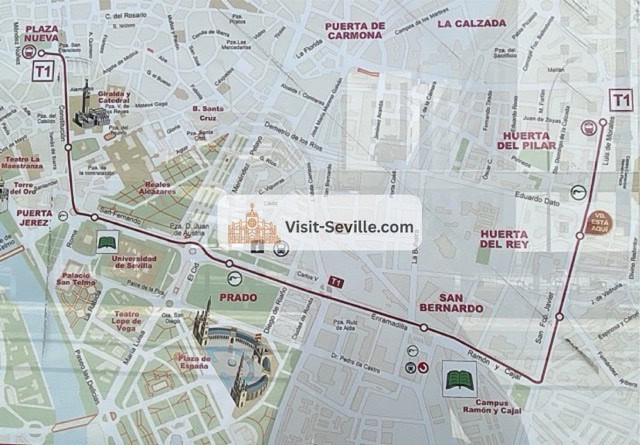
For the latest information on stations and routes please check the Official Seville Tram website.
Useful Tips for Riding the Seville Tram
- Eduardo Dato stop (as of 2025): Only one platform is currently in use, the one on the same side of the street as the Sevilla FC Stadium. Both directions stop here, so the tram heading into the city centre doesn’t use the platform opposite, but shares the same tracks as the one going towards Nervión.
- Prado stop: Don’t be surprised if the tram pauses here for a few minutes. Prado is Seville’s main transport hub, so trams and buses often wait a little longer to readjust their schedules. This is completely normal, you don’t need to get off, just sit tight until the tram continues.
- Metro connections: You can connect to Seville Metro Line 1 directly from several tram stops, including Puerta Jerez, Prado, San Bernardo and Eduardo Dato.
- Accessibility: Although the metro is equipped with elevators and the buses with ramps, many travellers find the tram more comfortable and less hassle if you’re using a wheelchair or pushing a pram. The trams are also more spacious inside, which is why some visitors prefer them over other ways of transport.
- Stop announcements: Unlike the buses in Seville, the tram clearly announces every stop in both Spanish and English. So if you’re unsure where to get off, don’t worry as you’ll hear the name before arriving.
Future Plans for the Seville Tram
The Seville tram (MetroCentro) originally reopened in 2007 after the old tram network (1866–1965) had been closed for decades. Since then, the line has been gradually extended, with the recent additions of the Eduardo Dato and Luis de Morales stops in November 2024.
The next phase is to take the line further east, reaching Santa Justa train station, Seville’s main hub for AVE high-speed trains. This will involve new stops, improving connections between the city centre and long-distance rail services.
Seville Tram: Frequently Asked Questions
How much does it cost to ride the Seville tram?
A single Seville tram ticket costs the same as a standard Tussam bus ticket (€1.40). Tickets can be purchased from vending machines at tram stops, or you can tap your debit/credit card on the machines inside the tram.
What are the operating hours of the tram in Seville?
The Seville tram usually runs from early morning (around 6:00 am) until midnight on weekdays, with extended hours on weekends and holidays. Frequency is every 7–10 minutes during peak times and slightly less often in the evenings.
More on Visit-Seville

